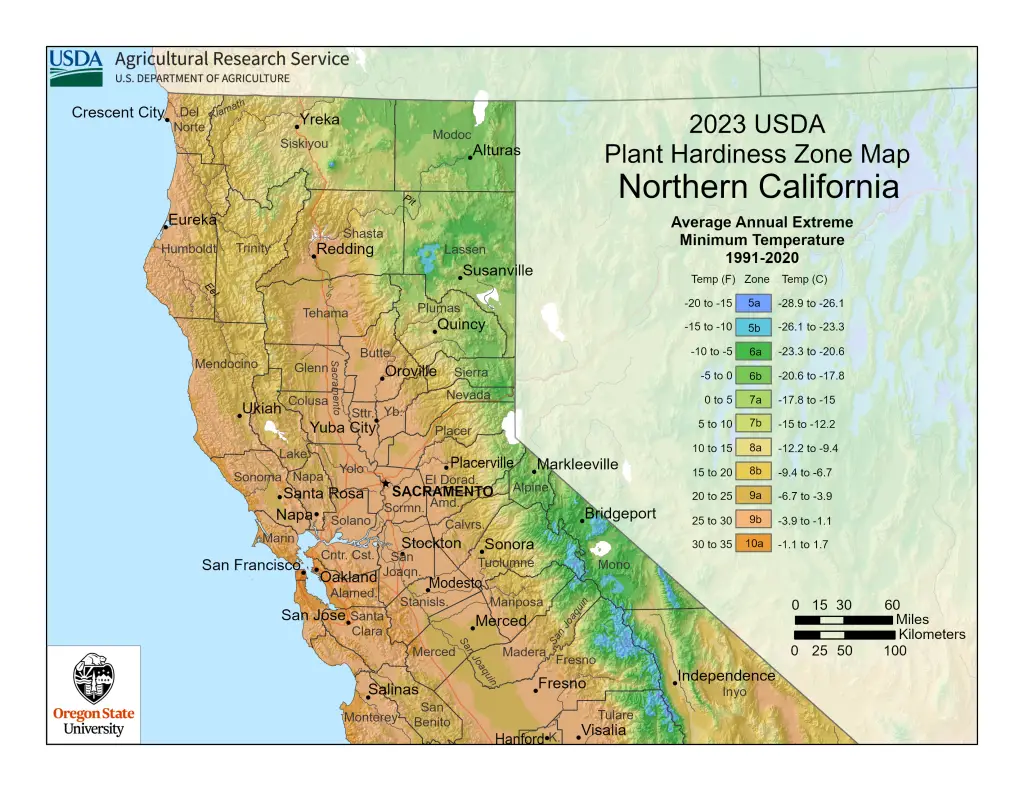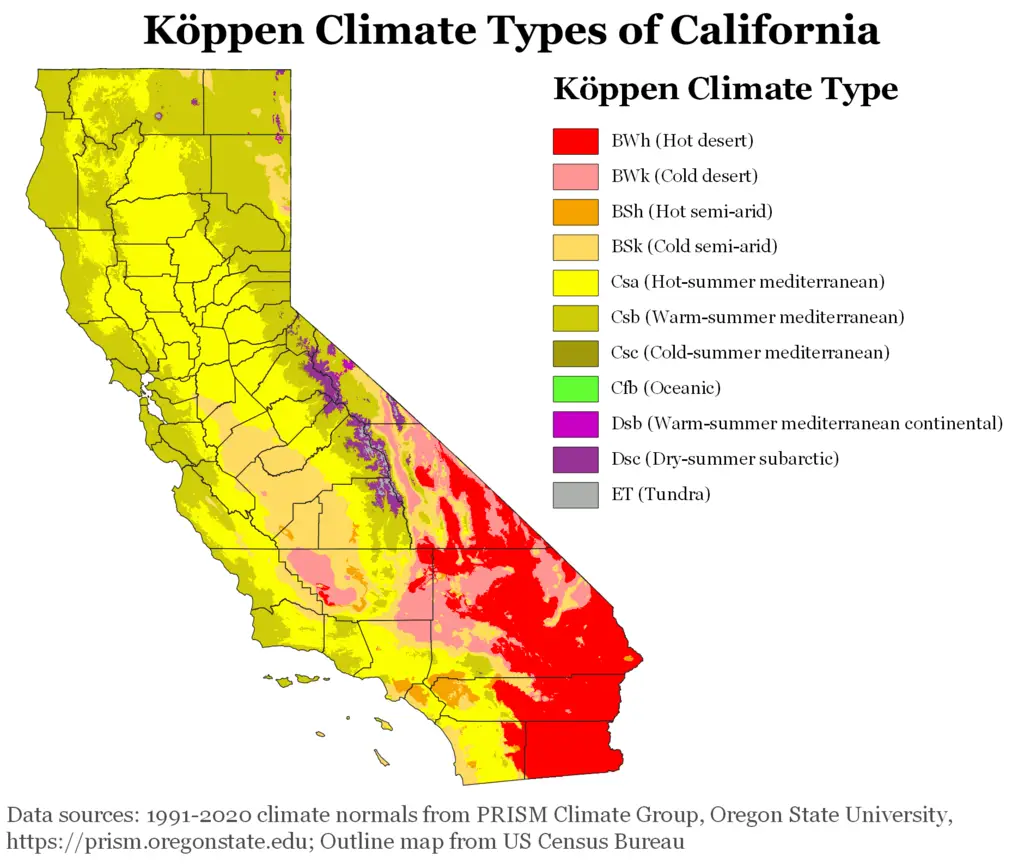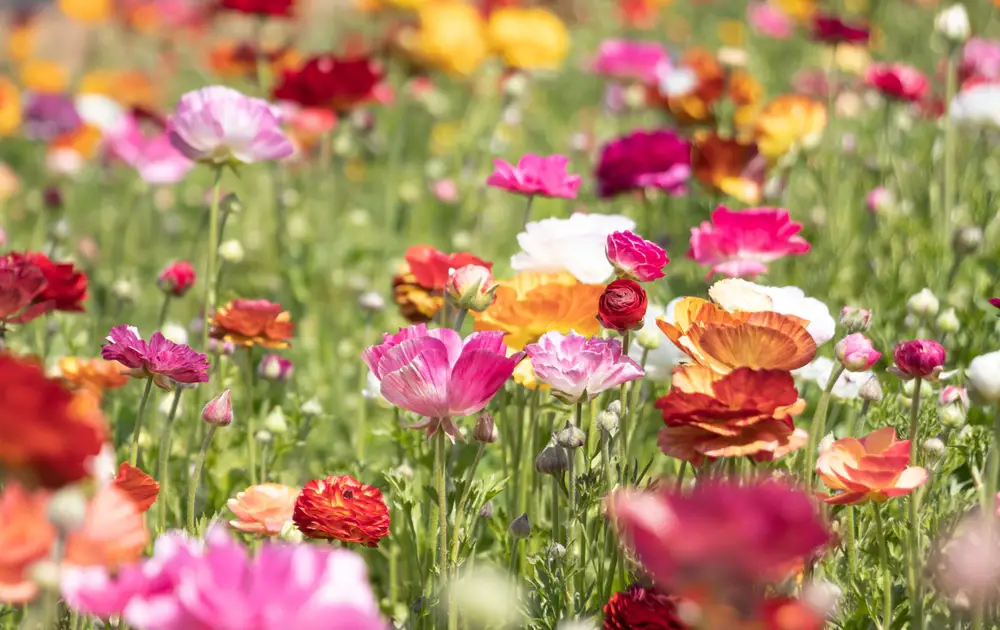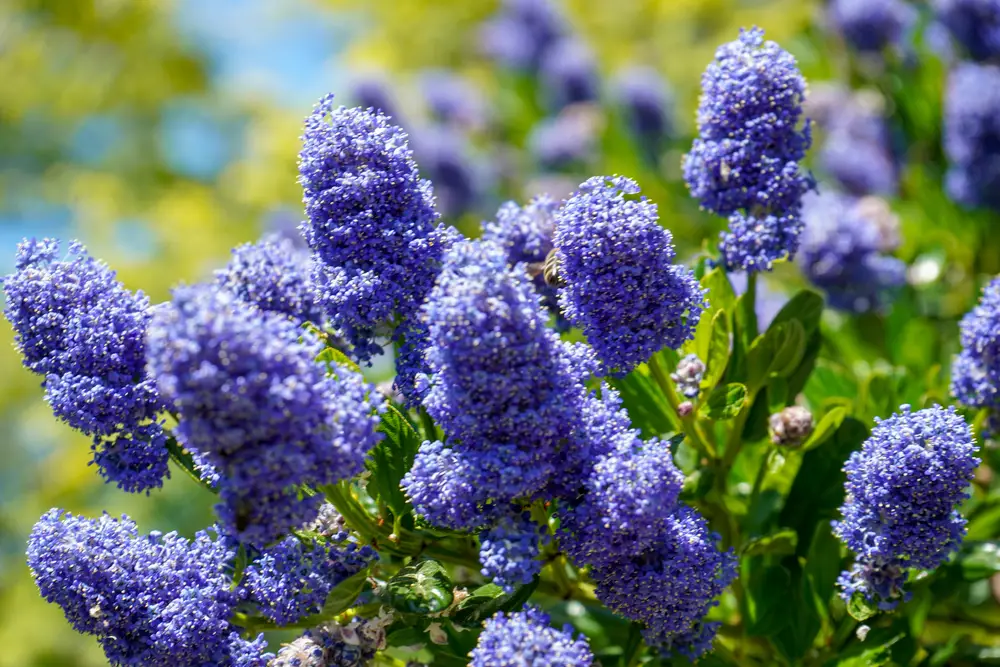Summary1-11
California plant hardiness zones include zones 5a-11a. Its average minimum extreme winter temperatures range from -20°F (-28.9°C) to 45°F (7.2°C).
The third largest state in the USA, California features a lengthy coastline, mountains, desert, and considerable forests. Given its size and topographic diversity, the climate varies considerably from region to region.
Though California has several different climate zones, the three most widespread are warm summer Mediterranean, cold semi-arid, and hot summer Mediterranean. It can also have occasional tundra conditions in the high Sierra Nevada mountains.
Due to this diversity, gardeners are able to successfully grow a wide variety of plants but must consult specific regional recommendations to determine the best gardening practices and plants for their area. The growing season in California is long, and in some locations, conditions can support year-round gardens. Drought is an ongoing concern for many regions, and choosing native species and water-wise practices increase garden viability and success.
Plant suggestions include:
- California Buckeye
- Western redbud
- California Lilac
- California Poppy
- Coastal Prickly Pear
- Yarrow
- Milkweed
California Plant Hardiness Zones


| USDA Hardiness Zone | Average Minimum Extreme Winter Temperature Range Fahrenheit (°F)Celsius (°C) | Average Last Frost Date Range In Spring (Beginning Of The Growing Season) | Average First Frost Date Range In Autumn (End Of The Growing Season) |
| 5a | -20°F to -15°F -28.9°C to -26.1°C | Late May | Late September |
| 5b | -15°F to -10°F -26.1°C to -23.3°C | Early to mid-May | Mid-October |
| 6a | -10°F to -5°F -23.3°C to -20.6°C | Late April | Late October |
| 6b | -5°F to 0°F -20.6°C to -17.8°C | Late April | Late October |
| 7a | 0°F to 5°F -17.8°C to -15°C | Late March to early April | Early to mid-November |
| 7b | 5°F to 10°F -15°C to -12.2°C | Late March to early April | Early to mid-November |
| 8a | 10°F to 15°F -12.2°C to -9.4°C | Mid-to-late March | Mid-to-late November |
| 8b | 15°F to 20°F -9.4°C to -6.7°C | Mid-to-late March | Mid-to-late November |
| 9a | 20°F to 25°F -6.7°C to -3.9°C | Early to mid-March | Early to mid-December |
| 9b | 25°F to 30°F -3.9°C to -1.1°C | Early to mid-March | Early to mid-December |
| 10a | 30°F to 35°F -1.1°C to 1.7°C | Early to mid-February | Mid-to-late December |
| 10b | 35°F to 40°F 1.7°C to 4.4°C | N/A | N/A |
| 11a | 40°F to 45°F 4.4°C to 7.2°C | N/A | N/A |
California’s Growing Conditions1-11
General Climate

Much of California experiences relatively mild and warm weather, but there are still wide variances. For example, Death Valley holds the record for the hottest place recorded on Earth. Compare this to the high elevations in the Sierra Nevada mountain range, where summer temperatures peak between 30°F and 50°F (-1°C – 10°C).
The Coastal regions north of Los Angeles, northeastern California, and Sierra Nevada foothills are classified as warm summer Mediterranean. Due to their proximity to the ocean and the cool currents of the Pacific Ocean, the coastal areas from Los Angeles to the Oregon border, northeastern California, and the Sierra Nevada foothills experience wet winters and mild summers with temperatures averaging 72°F (22°C).
Central Valley and much of middle inland California from north to south are classified as hot summer Mediterranean. These areas experience hot summers and relatively mild winters with regular precipitation.
California’s south coast is classified as cold semi-arid. The coastline south of Los Angeles gets colder winters (with at least a month of temperatures below freezing) and warm summers.
The highest peaks of the Sierra Nevada mountains feature tundra conditions. Summer temperatures are between 30 °F – 50 °F (-1 °C – 10 °C).
Most of southeastern California is classified as a hot desert. There is little to no precipitation, no cloud cover, and some of the hottest temperatures on the planet. This is where Death Valley is located.
Microclimates
USDA plant hardiness zones are an important starting point for your garden, but you’ll also need to consider microclimates.
Microclimates are areas where specific conditions create a climate different from the climate they’re situated in.
Buildings, fences, paved areas, or short hills and valleys can create these microclimates.
They can be as small as a space in your backyard or as large as a city.
In other words, learn about your local conditions from local experts to see if your garden falls into a microclimate.
Extreme Weather
No stranger to extreme weather, damaging weather events are becoming increasingly more regular in California.
It can be hard to tell whether California is becoming wetter or drier. The answer is it’s actually becoming both.
Drought
California is prone to drought. Though drought has historically been a problem in this region, due to the combination of planet-wide warming and various weather-related complications, California experiences ongoing drought conditions and related challenges.
Drought impedes landscape and plant health in a variety of ways, making it harder to continue growing each season it persists.
When plants don’t have access to enough water, they are unable to move nutrients through their systems. This stunts their growth, and they become more susceptible to disease and pests. In extreme cases, they simply die.
When soil becomes too dry, the invertebrates and microbes living within it also die. Without decomposers recycling nutrients and moving through the soil, it is prone to becoming compacted, making growing significantly more challenging.
Government agencies and citizen coalitions have been working in earnest for decades to mitigate drought conditions in various regions of California.
If you’re living in drought conditions, we suggest:
- Planting species adapted to arid climates
- Replacing lawns with less needy alternatives
- Mulching
- Generally reducing water use in the garden
- Watering in the morning or at night to avoid losing water to evaporation
- Improving soil quality to improve its water-carrying capacity
Flooding
Heightened temperatures amplify and worsen drought conditions and forest fires while also allowing the atmosphere to hold more water vapor than in times past. This creates a situation where heavy rains and windstorms cause significant damage. The land can’t absorb the excess water, and it runs off to the ocean, leaving an increasingly large wake of destruction in the form of floods and landslides.
While atmospheric rivers, or corridors of fast-moving and extreme concentrations of water vapors, are essential to maintaining the water supply, global warming means they are increasing in intensity, size, and frequency and the damage they create.
In California, precipitation can take the form of rain or snow.
If flooding is a regular occurrence in your garden, plan to mitigate its effects as best as possible.
At the very least, you must ensure adequate drainage so water can move through your property without causing damage.
Gardening in raised beds is another option, as are rain gardens. The latter is a type of garden that temporarily holds excess water until the water slowly penetrates into the soil.
Growing Season
Much of California has a long and wonderful growing season.
High in the Sierra Nevadas, the growing season is 50 days. Along the southern coast, the growing season lasts all year long.
Given the state’s size and the variation of topographic elements affecting temperature, you will find it helpful to refer to the USDA hardiness zone map to determine average frost dates for their specific region (if applicable).
Some areas, such as Sacramento and San Diego, receive frost only very rarely.
California Gardening Tips

Choose The Right Plants
We always recommend selecting native species of plants. These are the plants from your region that have grown to adapt to local conditions, sometimes over thousands of years. Not only do they have the best chance of surviving, but they also give the best support to other species of plants and animals that have co-evolved with them.
Planting with a focus on native species in a Californian garden could mean a wide variety of things, such as planting drought-tolerant plants, plants that can tolerate extreme cold or heat, or those that do best when they receive consistent precipitation. This is due to the fact that California is a large and geographically diverse state. Each region’s climate will inform which plants are native to it.
Visiting your local plant nurseries and growers provides you with a wide selection of plants specific to your area and information about them.
Don’t forget to bring your questions! Gardeners of all experience levels are always learning, and just like the plants we work with, do best when we interact with each other.
Starting Seeds Indoors
In California’s cooler zones with short growing seasons, you can expand what you can grow by starting seeds indoors in February and March and transplanting to your garden once temperatures have warmed outdoors.
You may be interested in growing cool-weather crops such as lettuce, kale, broccoli, cauliflower, peas, and cabbage, but you may also live in very warm environments. In that case, you’ll increase your chances of success by starting plants as early as possible indoors and transplanting them out. This lets you grow them before heat peaks, causing them to spoil through a natural process called bolting before harvesting.
A plant “bolts” or switches its energy from developing to trying to reproduce (produce seeds) when temperatures exceed its comfortable range. Once the plant begins seed production, if it is a food plant, the quality rapidly declines, often becoming so bitter it is basically inedible.
Water Wise Gardening
In areas where drought conditions have prevailed, you will want to choose plants that will survive with less water. If possible, choosing perennial plants adapted to your specific region’s climate is best. This is because newly transplanted plants require additional water for their first season as they develop the kind of root systems that can sustain them in low-water conditions long into the future.
Using a layer of organic matter over the soil of plants, or mulching, can be helpful in capturing and retaining water for your plants.
Mulch also benefits you by:
- Improving soil quality as it breaks down
- Suppressing weeds
- Protecting roots from heat damage or stress
- Inviting healthy garden predators that will keep pest populations down
How and when you water your plants also affects your water efficiency. Water low to the ground, underneath plant foliage, to avoid splash up and potential transmission of disease from the soil. Watering early in the day before the heat has accumulated will mitigate evaporation.
Deep watering once a week is better for your plants than little bits of moisture here and there. This is due to the fact that, provided your soil is healthy and able to absorb water, it will permeate deeper and remain in the soil (and available to your plants) longer.
Lastly, improving the quality of your soil by adding finished compost or other organic additives can only help manage water resources. Healthy soil has a higher water-carrying capacity and can readily absorb water when it is available (as compared to compacted or imbalanced soils).
Consult With Local Professionals
Consulting with local gardening professionals allows you to benefit from their experience with your area’s conditions, the plants that do well there, and overall best practices.
California Plant Suggestions

Trees
- Coast Redwood (Sequoia sempervirens)
- California Buckeye (Aesculus californica)
- Refugio Manzanita (Arctostaphylos refugioensis)
Shrubs
- California Gooseberry (Ribes californicum)
- California Lilac (Ceanothus genus)
- California Sagebrush (Artemesia californica)
Flowers
- California Poppy (Eschscholzia californica)
- Yarrow (Achillea millefolium)
- California Milkweed (Asclepias californica)
Vegetables
- Cucumbers (Cucumis sativus)
- Beans (Phaseolus vulgaris)
- Beets (Beta vulgaris)
Herbs
- California Amaranth (Amaranthus californicus)
- Cilantro (Coriandrum sativum)
- Rosemary (Salvia rosmarinus)
Spices
- Saffron (Crocus sativus)
- White Sage (Salvia apiana)
- California Bay Laurel (Umbellularia californica)
Fruits
- California Wild Plum (Prunus subcordata)
- Wild Almond (Prunus andersonii)
- Wild Grapes (Vitus californica)
Succulents
- Coastal Prickly Pear (Opuntia littoralis)
- Chalk Dudleya (Dudleya pulverulenta)
- Coastal Agave (Agave shawii)
Disclaimer
Any of the above can change and is not exhaustive.
Treat anything above like a good starter guide. Then use that as a foundation as you consult with local gardeners, professionals, forecasts, guides, and organizations.
Sources
- “Sunset Climate Zones”. Sunset. Accessed April 3, 2024.
- “Climate of California”. Wikipedia. Accessed April 3, 2024.
- “Climate of California” Britannica. Accessed April 3, 2024..
- “Weather and Climate”. Study California. Accessed April 3, 2024.
- “California Weather, Climate and Geography”. World Travel Guide. Accessed April 3, 2024.
- “California Climate”. Western Regional Climate Zone. Accessed April 3, 2024.
- “California Interactive Plant Map”. Plantmaps.com. Accessed April 3, 2024.
- “What My Climate Zone?”. UC Master Gardener Program. Accessed April 3, 2024.
- “USDA Plant Hardiness Zone Northern California”. USDA. Accessed April 3, 2024.
- “USDA Plant Hardiness Map Southern California”. USDA. Accessed April 3, 2024.
- “First and Last Frost Dates for Places in California”. Almanac. Accessed April 3, 2024.


